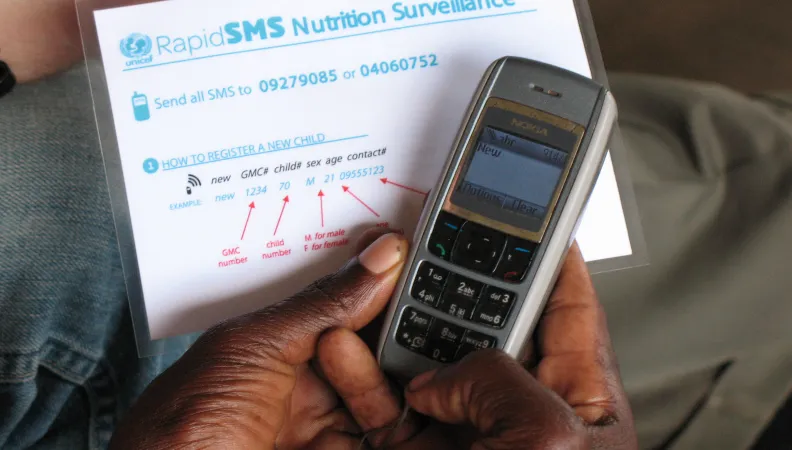Share the page
In Rwanda, “hospitals can now use RapidSMS data to get ready for new arrivals!”
Published on
Samir Abdelkrim Entrepreneur and consultant StartupBRICS.com

The RapidSMS telemedecine platform makes it possible for Community Health Workers (CHWs) to share data: between 2009 and 2015, it helped to save the lives of around 590,000 new-born babies and it has cut infant mortality in Rwanda quite significantly.
From his tiny office on the second floor of Rwanda’s Health Ministry, Eric Gaju is running a pioneering connected health department. Since 2009, he has been heading up the RapidSMS project, the first African e-health app to have checked the rise of infant and maternal mortality in an entire country over a lasting period. It is a sort of medical “M-Pesa”, i.e., the mobile banking system that originated in Kenya and is now used by nearly 30 million people. According to 2016 figures published by the United Nations Children's Fund (UNICEF), it managed to save the lives of 590,000 Rwandan babies between 2009 and 2015.
How did RapidSMS get off the ground?
Eric Gaju: In 2009, infant mortality among babies less than one year old was very high: around 47 deaths for every 1,000 live births. The Rwandan Ministry of Health, noting the country’s soaring mobile telephone penetration rates – even in the most out-of-the-way places – decided to harness the new practice of telemedecine in partnership with UNICEF in a bid to bring our infant mortality rates down to average international rates. UNICEF provided us with specialist e-health consultants to help develop a prototype in partnership with Rwandan tech companies. The aim was for locally-recruited Community Health Workers (CHWs) to use text messaging to signal high-risk pregnancies to the nearest hospitals.
Where did you begin tests?
The first tests were carried out in several isolated villages in the landlocked region of Musanze in northern Rwanda. It is a very hilly region and it’s difficult for the people there to have access to decent healthcare. We felt that if RapidSMS managed to reduce infant and maternal mortality here, then we could roll this technology out throughout Rwanda. After six years of tests followed by nationwide deployment, RapidSMS cut the number of deaths for every 1,000 live births to 31 in 2015, just below the international average.
How do CHWs actually use the app?
The Ministry of Health recruits three Community Health Workers in each village – usually two women and one man – who are trained to detect and text warning signs of complications in pregnancies among women of child-bearing age, i.e., between around 15 and 49. These workers liaise and pool information: each problem is identified and brought to the attention of either the emergency services or a neighbouring hospital which can then intervene. The CHWs have a list of codes in the form of acronyms, corresponding to the most urgent conditions that need to be signalled immediately: haemorrhaging, fever, malnutrition, etc. For example, the shortcode RED means that the patient’s situation is life-threatening. NP means there’s No Problem and the pregnancy is proceeding smoothly.
What is the advantage of having so much data in real time?
Well, the mass of data sent by SMS enables the hospitals concerned to forecast the number of expected deliveries over the next two weeks with a fair degree of accuracy and to organise the services concerned accordingly. For example, if they expect to deliver 50 babies next week, the medical services concerned will make sure the necessary staff are available during that period. The accuracy of the data sent in by the CHWs also enables doctors to identify the more problematic cases from among the 50 expected deliveries and to take certain measures in advance.
How many CHWs are currently involved?
The Ministry of Health has recruited and trained 45,000 Community Health Workers in 12,000 villages across Rwanda. The CHWs are not government-appointed but are elected by the village community and paid based on the quality of the information sent in by SMS. It is the government that provides each CHW with mobile phones and ensures that these are working properly.
Are they actually smartphones?
We use basic mobile phones for RapidSMS – these are quite sufficient for sending text messages. They go on working for several days even during power cuts. We don’t need smartphones – we make sure that imported technologies are suited to our needs and constraints. For example, South Korean business people came to see us: they wanted to provide our CHWs with the very latest Samsung smartphones. But the battery on these phones runs down in just one day and there’s no electricity in isolated Rwandan regions! So we turned down this offer on pragmatic grounds.
Do you have to pay for RapidSMS?
The platform is completely free and the costs are picked up by the government. Incidentally, RapidSMS was developed entirely in Rwanda using free Open Source software. This means that anyone can download the app and configure it in line with their own needs. For example, the Zambian Ministry of Health has completely customized RapidSMS with new features to help it in its fight again malaria.

